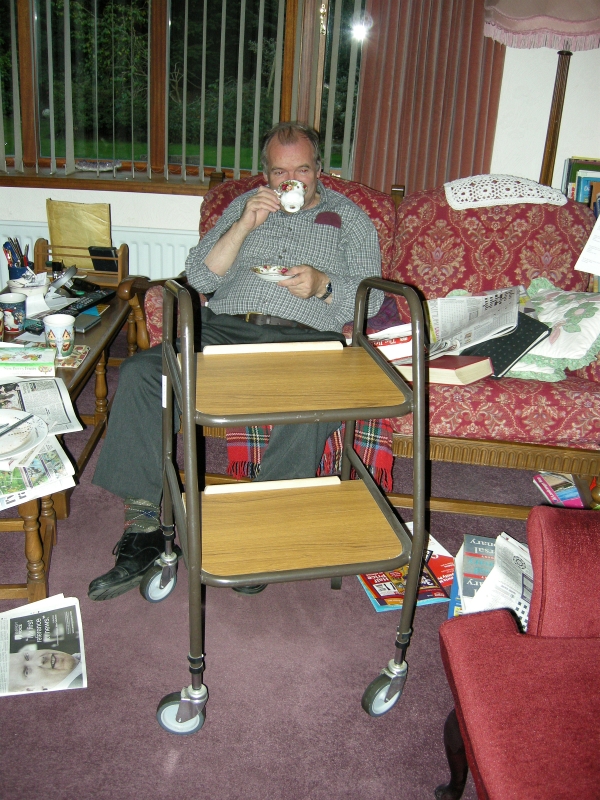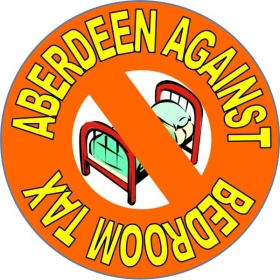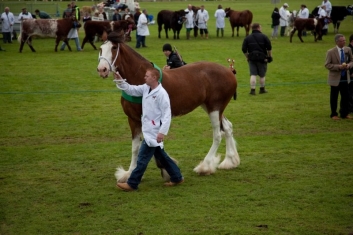Old Susannah, aka Suzanne Kelly, gets to grips with her greens this week, with the never-ending Union Terrace Gardens saga, GM crops and various vegetables – including Eric Pickles – all vying for news coverage this past week.
Another vibrant and dynamic, connectivity-laden, smart, successful Scottish week passes in Aberdeen.
The weather is taking a turn for the cooler at night, and I’m starting to throw old unread copies of the Evening Express (is there any other kind?) onto the fire at night (living without central heating has its charms).
Alas, I’ve been down in London and missed many events here, including Thrashist Regime, who I’m told were so lively the staid Lemon Tree staff were freaking out at all the rule infractions the band committed.
London was wonderful, but the Londoners seem to think they can manage without one central square smack in the geographical centre of town. Somehow they carry on, in a city which is more like a series of different villages, each with its own ‘green/living/vibrant/dynamic’ heart, as our Evening Express reporters would put it.
Why, they haven’t even drawn up a map to show what is the Civic Zone or the Merchant Quarter, like we’ve done. London clearly needs a transformational project – if only one man with a horrific – sorry terrific vision would come along, put money on London’s table (well theoretical money anyway) and tell Boris Johnson what to build and where to build it, London would start to thrive.
Thankfully, we have Sir Ian Wood.
Looking at aerial maps of London, huge great green open spaces abound. Some call these parks/wildlife reserves/wetland centres/leisure spaces. Some people hold that these green spaces help give London a decent air quality, encourage wildlife, provide leisure space – even decrease stress levels and improve fitness.
Such spaces are, at least to the more sophisticated billionaire and ACSEF member, development opportunities. Oddly, London chooses to build in its disused brownfield rather than ‘transforming’ its green areas. Thankfully, we’re not falling for that stuff here. (I did hear a rumour that Hampstead Heath was going to be lowered to ground level for greater accessibility and connectivity. Watch this space).
Trafalgar Square remains a focal point, but it is far too small.
That will make London and Moscow take note.
At some 12,000 square metres for a population that’s around 8 million, it’s clear they are out of step with our Aberdonian city square project, otherwise known as the thing that wouldn’t die. Our much needed outdoor square will, if Sir Ian gets his way, be larger than Moscow’s Red Square.
Perhaps Aberdeen’s quangos, committees and elite have more in common with Moscow than London, come to think on it.
The City Square/Granite Web/Garden Project is proof that reincarnation is real; the thing just keeps coming back under new names, with increasingly beautiful, workable, desirable details. Our broken heart (aka Union Terrace Gardens) could have had a new beating heart (copyright Evening Express), dwarfing both Trafalgar and Red Squares, for our population which is around, er, a quarter of a million people.
That will make London and Moscow take note.
You have to hand it to Sir Ian Wood (or so he thinks); he is persistent. If half the goings-on I hear of were true for his retinue, finding time for any granite web project flogging would be nigh on impossible.
Aside from London’s museums, I saw the amazing Deborah Bonham and band at the Half Moon in Putney; I hope that someone is working on getting them an Aberdeen date…
Returning from London to the Deen, I eagerly bought the first P&J I could find, and started to catch up on the news; learning that former top cop Ian Paterson has just been found guilty of sexually harassing and assaulting several women over time. Looking back over old news stories, council records and so on, I find he was involved not only with the AVCO but also with groups working with young and vulnerable people. How wonderful.
Old Susannah remembers first moving to the Deen, and reading stories about old people being neglected, abused and mistreated in residential homes. There was even a home that had a broken lift for weeks – leaving people stranded and unable to get outside (I’ll bet it was a jolly adventure and fun for them, rather than a hardship).
Some might find his behaviour sleazy, contemptible, inexcusable, predatory and degrading
Naively I wanted to do my part, and I called my nearest residential home, asking how I could volunteer / help. ‘Oh, no, you have to get all kinds of clearance and be security checked’ was the response I got; I was definitely discouraged from taking it further. Fair enough – leave the volunteer work to the professionals, I thought.
All the while, some people were allowed access to vulnerable, young and old people because they were important – like Paterson.
Kindly, Patting Paterson would ‘comfort’ women – whether they wanted him to or not – by touching them where he had no business touching them. Sounds very comforting indeed. Then again, he only did this for a few years to a score of women. If those around him knew about this, they were quite right to leave it be, so he could continue ‘comforting’ others.
Some might find his behaviour sleazy, contemptible, inexcusable, predatory and degrading, but you can’t argue with a policeman, or indeed an ex-policeman, can you?
Old Susannah wonders now just who his friends/colleagues were (kerb crawling ex-councillors perhaps like Gordon Leslie?). Who knew what of his activities? What work was he presiding over as Chief Superintendent, or as chief executive of Aberdeen Council of Voluntary Organisations?
Could his actions and decision-making have been compromised at any time? Could he have been coerced or influenced by people who knew what he was doing? Was he around when the police were tasked by Audit Scotland to look into the dodgy property dealings uncovered in 2008?
Thankfully, we don’t need to bother with any such questions, because it’s all in the past. The police could find no wrong-doing on the former council’s part, for instance when we sold land for peanuts, ripping off the taxpayer, and keeping very shoddy records. Who knows what could be unravelled, but I’ll certainly not be pulling at that loose piece of yarn on the jumper, will I?
Time for some definitions (and a shot of BrewDog’s Watt Dickie) after thinking over this week’s news. Note to self – I must try some ‘Hello my name is Sonja’, a new addition to the ‘Hello’ BrewDog collection. And to Messrs Dickie & Watt, and all at the BrewDog Aberdeen Bar, a Happy Third Birthday.
Garden Salad: (modern English compound noun) – A dish comprising leafy and other vegetables, or a recipe for same.
Take one small, perfectly formed natural hollow, fill with trees, greens and flowers. Add greed, a pinch of desperation for immortality, and lashings of ego. Add in various vegetables (Tom Smith, Ian Wood, Stewart Milne, etc.) and toss. Add a few hundred inches of column spaces, revoltingly poor architectural grandiosity, and unintelligible drawings.
Garnish lavishly with hundreds of thousands of pounds of taxpayer money (for consultants, PR, etc.). Serve with a side helping of indigestible financial sauce. Add £50 million pounds; remove; add again; remove. This dish can be served again and again. And again. Keep serving until someone, somewhere swallows. Best eaten out of Sir Ian’s hands.
Yes, he’s at it again. We can’t keep our only city centre green space, despite having so much unused brownfield, because Wood wants it.
Barney Crockett has promised that if the garden is raised, it will not be for parking spaces – which are what was wanted by the ACSEF/Wood mob in the first place. If you have any opinions on this, please let your elected councillors know, lest they then turn around and say no one ever got in touch with them.
Let your council know how great a glass pyramid will be, or how ruining the back side of Belmont Street’s businesses which overlook the park will somehow add to connectivity. Tell your councillor how destroying our only natural wind break, getting rid of the few city centre trees we have will mean to your sense of transformation.
Pickles: (English noun) A sour, bitter, bloated vegetable, preserved in brine.
Eric Pickles. Where does one even start with this one man’s accomplishments? He’s been in the news again lately, and like me, I’m sure you relish reading about him. I love to ketchup with his doings, even if some people find Pickles unpalatable.
MP Pickles claimed expenses for a second home so he wouldn’t have to commute the massive 37 mile trek from his first home to Westminster. (I wonder if Pickles’ second home is close to the Gherkin?) This may have seemed a bit greedy to some, but for Eric to have to travel so far to get to work just wouldn’t have been right.
If he was tired in the House of Commons, he might not be able to cut the mustard. He also needed at least £300 in cleaning expenses, which he kindly repaid when asked to, at the height of the MPs expense scandal.
One of the reasons he’s rated so highly is his love of the countryside, as development opportunity anyway. As Secretary of State, he refused to call in controversial plans which saw a vast swathe of historic Dover and an Area of Outstanding Natural Beauty turned into a housing development / complex.
Area residents found Pickles jarring.
If the refusal to listen to a public demand sounds familiar to anyone in the Balmedie area, another quote from this particular debacle may ring bells with Union Terrace Gardens watchers: defenders of the plan said “This is about building for the future; unlocking the economic potential of our heritage assets.” – the tone of which somehow seems familiar to me.
http://pickles_public_inquiry_into_controversial_development
You can’t help but wonder if Pickles and his supporters would find a spiritual home in city and shire.
teenagers at the Kendall House home in Gravesend were restrained with huge doses of tranquillisers
He was also instrumental in getting rid of greenbelt in Yorkshire, Liverpool and other formerly boring areas in favour of skyscrapers and parking lots- and a gas plant in Tewkesbury where the objections were virtually unanimous. We do need a man of his vision here.
But in his latest pickle, Eric told a woman with health issues, who had severe side effects to ‘increase her medication’ as he wisely disputed her story of residential care home forced drugging. His friend (yes, I didn’t know he had any either) told the BBC that Pickles “was giving her a frank piece of advice in private. It wasn’t meant in any way to offend or insult her”.
What a nice guy. http://www.bbc.co.uk/news/uk-politics-24324556
The BBC story goes on to say “An investigation… claimed that teenagers at the Kendall House home in Gravesend were restrained with huge doses of tranquillisers and other drugs… 10 girls who were heavily sedated while living at the care home during the 1970s and 1980s went on to have children with a range of birth defects.” – Doesn’t sound like much of a big deal to me; perhaps upping her medication was just Eric’s fatherly, well-meant advice. With Pickles around, there is never a dill moment.
Golden Rice: (Modern English noun) A genetically modified, patented rice variety.
Are you one of those people who are unsure about GM foods – not certain that Monsanto should be able to splice genetic material from arctic fish into strawberries, own entire strains of food, seek a monopoly on existing seed businesses, charge farmers each season for food crops rather than farmers being able to store and use their own seed?
Are you unsure about environmental and health aspects of newly-nascent GM plants entering our food chain? Do you have ethical qualms about the third world being indebted to Monsanto forever for using GM food? Maybe you’re not convinced farmers should be sued for theft when GM pollen gets into their own crops (as happened in Canada)?
Then Minister Owen Paterson knows what you are: wicked.
Paterson said as much to the BBC; quite rightly too. The proliferation of GM food into our environment is nothing to fear at all, no more so than when the pesticide DDT came into wide use, and was hailed by the Patersons of the day. Of course, traces of the deadly stuff can now be found in EVERY living organism in the planet, but there you go; no harm done.
There may have been the occasional reason to harbour doubts about scientific advancements, but Science is always right, and technological advances are not made for profit, but for the betterment of the world in every instance. The odd nuclear accident, Thalidomide birth defects, tranquilisers with deadly side effects such as Halcyon – that sort of thing doesn’t happen anymore, well hardly ever.
Don’t question, don’t worry, don’t object – doing so is wicked. Where would we be without the guiding moral compass of Paterson and his ilk?
You wicked people should be ashamed; Paterson also says it is your fault people are starving in the third world, and golden rice will solve everything. That’s you told, then. And here I was thinking centuries of colonialism, civil war, disease, violence and draught were to blame.
Next week: A look at recent Trump news including his classy new roadside sign and 2012 accounts; a glance at Stewart Milne-related news, and more definitions.
Confidential to anyone who is feeling old: In passing, someone in their mid 50s told me they were old. First of all, I was Old Susannah way before anyone else decided to be old. Secondly, don’t be old if you don’t want to be old. One of the most youthful people I’ll ever meet was Les Paul (the guitarist and innovator).
I had the extreme pleasure of watching him play many times. There was nothing like it; the music he made; the passion for what he was doing all kept him at a mental age of perhaps 21. He’d joke; he always smiled; he had a twinkle in his eye, and he loved every moment. (And I wish I could see and hear him again). Did he have pains, aches, heartache, problems the same as the rest of us? Absolutely. He just chose to be young.
I hope to be as young as he was one of these days. Anyone who’s reading this at a computer/phone, in a warm building with food in their stomach is pretty lucky compared to most of the rest of the world, something too easily forgotten. If you have some kind of talent or gift, you have much more reason to lighten up.
Refuse to be jaded. Carpe Diem. Do something new. Go somewhere you’ve never been. Go on an adventure. Start something. I can promise you, you can stay young in heart and mind if you want to. As they say, ‘this is not a dress rehearsal’.
- Comments enabled – see comments box below. Note, all comments will be moderated.
















